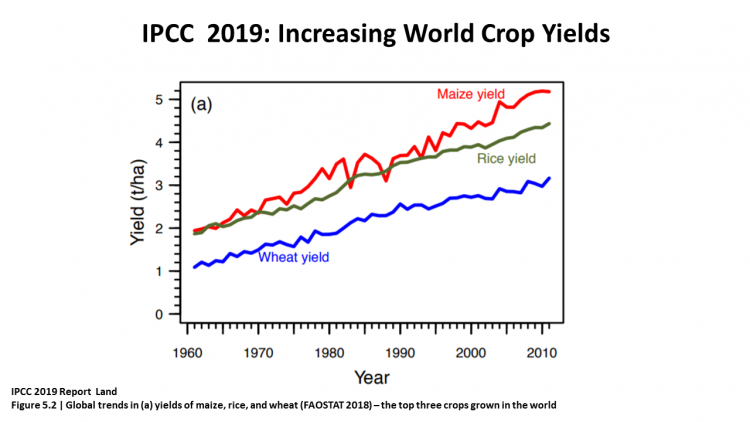Climate change and Food Security
IPCC 2019 Land Report
Ch. 5 Food Security
IPCC 2019 Land Report
Ch. 5 Food Security
ALL CROPS
IN ALL REGIONS
DECLINE
WITH INCREASING WARMING
AND CLIMATE CHANGE
DECLINE
WITH INCREASING WARMING
AND CLIMATE CHANGE


IPCC 2019 Special Report on Climate Change and Land
SPM A2. Since the pre-industrial period, the land surface air temperature has risen nearly twice as much as the global average temperature (high confidence). Climate change, including increases in frequency and intensity of extremes, has adversely impacted food security and terrestrial ecosystems as well as contributed to desertification and land degradation in many regions (high confidence).
Executive Summary
Food security will be increasingly affected by projected future climate change (high confidence).
Given increasing extreme events and interconnectedness, risks of food system disruptions are growing (high confidence).
Vulnerability of pastoral systems to climate change is very high (high confidence).
Pastoralism is practiced in more than 75% of countries by between 200 and 500 million people,
5.1.1.2 Effects of climate change on food security
Climate change is projected to negatively impact the four pillars of food security – availability, access, utilisation and stability – and their interactionsObserved climate change is already affecting food security through increasing temperatures, changing precipitation patterns, and greater frequency of some extreme events (high confidence).
5.2.2. At the global scale, (2018) climate change between 1981 and 2010 has decreased global mean yields of maize,
wheat, and soybeans by 4.1, 1.8 and 4.5%, respectively, relative to preindustrial climate. For rice, no significant
impacts were detected.
This suggests that climate change has modulated recent yields on the global scale and led to production losses, and that adaptations to date have not been sufficient to offset the negative impacts of climate change, particularly at lower latitudes.
This suggests that climate change has modulated recent yields on the global scale and led to production losses, and that adaptations to date have not been sufficient to offset the negative impacts of climate change, particularly at lower latitudes.
FAO-IPCC EXPERT MEETING ON CLIMATE CHANGE, LAND USE AND FOOD SECURITY, January 2017
Climate change is expected to impact on crop production, livestock production, fisheries and aquaculture. There is robust evidence of negative impacts from heat and water stresses on crop yields
1.1 Projected productivity changes and extreme events
1.1.1 Crops
In terms of global temperature and the yield response curves for crops such as wheat and maize, the main change in AR5 compared with the Fourth Assessment Report (AR4) is that a 1 or 2 ºC warming to increase yields in temperate regions is no longer expected

IPCC 2014 5th assessment AR5 Ch 7 Food
7.4.1. Projected Impacts on Cropping Systems Crop yields remain the most well studied aspect of food security impacts from climate change ,with many projections published since AR4.
These newer studies confirm many of the patterns identified in AR4, such as negative yield impacts for all crops past 3°C of local warming without adaptation, even with benefits of higher CO2 and rainfall